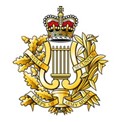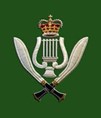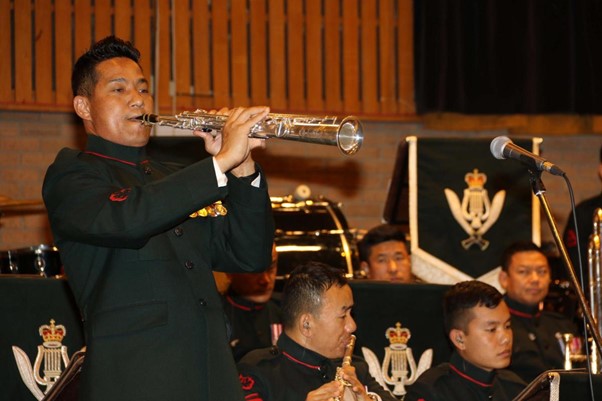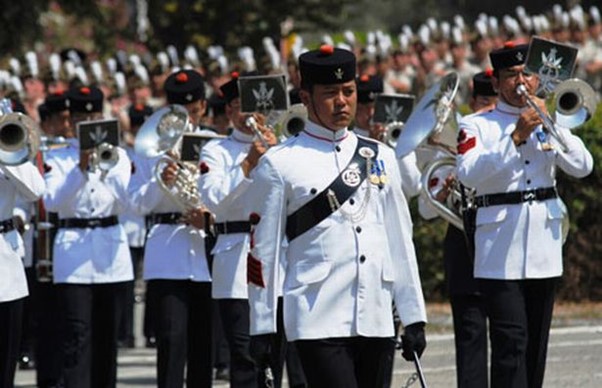

Located at Shornecliffe’s Sir John Moore Barracks Barracks, Folkestone, the Band of the Brigade of Gurkhas, coming under the ‘ceremonial’ dimension of the British Army through the ‘Corps of Army Music’ (‘Camus’) – insignia to far left with badge of the Band of the Brigade of Gurkhas to right — provides a unique synthesis of Gurkha focus on a given skill and activity (with certain distinct Nepali-Gurkha music culture aspects, such as Nepal and Gurkha musical compositions and musical instruments) and traditional British military culture in the domain of music. The latter is most famously associated with the Royal Military School of Music (RMSM), its repertoire of military music associated with the British Army over centuries (and more broadly beyond the military context), and the School’s equally legendary home, Kneller Hall, Twickenham. Camus includes: Symphonic Wind Bands, a Mounted Band, Brass Bands, a String Orchestra, Rock/Pop Groups, Fanfare Trumpeters, Small Ensembles (quintets etc), and Traditional Folk Music Groups.

The Band is one of the elite components of the Corps of Army Music – which includes for example: The Band of The Household Cavalry; The Band of the Grenadier Guards; Band of the Coldstream Guards – and as such has national/UK, and international (Western/European, AND Nepali) marches and other musical compositions of great renown in its repertoire.
When not engaged in their main [largely peacetime] purpose, of musical performance, Camus bands, such as the Band of the Brigade of Gurkhas, assist also in battlefield medical duties and stretcher bearing.
Just as regiments, squadrons and other components of an army are best known through their respective renowned heroes and the key engagements in strategically [and symbolically] important military action campaigns in major theatres of war crucial to the preservation/defence or global influence of the nation, so in the domain of military music, the given band is renowned for its repertoire of musical pieces. This certainly applies to the Band of the Brigade of Gurkhas.
Some history:
The band, as with all comparable historic British Army regiment-associated military bands was associated with military action functions. The band was actually a part of the Gurkha, British Army’s special Nepal-raised, Gurkha, Sirmoor Rifle Regiment (created 1859) – operation area, British India: famous for its immediate antecedents role during the ‘Indian Mutiny’ critically important engagements such as the Siege of Delhi and Relief of Lucknow — which also was the ultimate origin of the Royal Gurkha Rifles : it had 16 members and a bandsman (a Naik: also Nepali). By 1886 the band had expanded in conjunction with the raising of a 2nd battalion.
A new band (56 members strong) was formed in 1949, post-British Raj, Post WWII, at the beginning of what has subsequently been known as the ‘retreat from empire’ era that affected the United Kingdom more than any other European colonial power. Between 1949 and 1951 a crucial phase of the Band of the Brigade of Gurkhas, took place; enabling its preparation to later become one of the elite, most internationally renowned British Army’s Corps of Army Music. Within the first 12 months of this phase a brigade staff band was created (two bands existing: one in the UK, and one in Hong Kong until 1994), and still more importantly from then until end of May in 1951 a substantial training initiative was undertaken on a functional rather than formal basis, with education and technical instruction by British military bandmasters and other particularly renowned musicians in the army.
By the 1st June 1951 this crucial retraining phase had been completed, and with its conclusion the Nepali-Gurkha bandsmen — as adept and successful at swift, very effective, focused successful learning of techniques in this special field as with better known military arts and sciences such as signalman, sapper, rifleman – had the practical technical knowledge and practice grounding for their modern late 20th Century to early 21st Century repertoire and national and international prowess.
In regard to secondary, important functions of the Band, some of its members provided important stretcher bearer services in the first Gulf War (whose purpose was to liberate Kuwait from Iraqi occupation) in the 1990 – 1991 period: in conjunction with this the [now no longer in existence] Gurkha Transport Regiment served in the conflict under the provided 28 [Ambulance] Squadron.
By 2019/2020 the Band of the Brigade of Gurkhas was rationalised due to financial reasons, to a single band of 30+ members. It also provides a detachment for ceremonial service at the Tower of London: https://www.gurkhabde.com/the-queens-gurkha-engineers-tower-of-london-detachment/
Accoutrements: The Kilmarnock
The Kilmarnock (otherwise known as the ‘pillbox hat’) was used by almost all of the original Gurkha regiments of the British Army (including its 19th Century to pre-1947 period). A completely unlooked for cross-cultural clothing and fashion development was to occur in 1930’s Britain when the Kilmarnock served as inspiration for the – in fashion history – much more famous, ladies ‘pillbox hat.’ There was in fact a hat known as the ‘Pilleus’ or ‘Pannonian Hat’ worn by Roman soldiers (Pannonia was a province of the Roman Empire in the central region of the River Danube) some two thousand years ago: from the name and shape of the cap it is likely the Kilmarnock therefore has very ancient, auspicious martial associations.
It is also interesting to find that the Kilmarnock in fact had its origins in the Gurkha component of, by extension, British military history at cultural level. Of all sections of the Brigade of Gurkhas it is the Band of the Brigade of Gurkhas that have preserved use of the Kilmarnock in their formal attire; in so doing they also preserve, through this continuity link to the earliest times of the Nepali-Gurkhas becoming an indispensable part of the United Kingdom’s military forces. The other, perhaps better known Gurkha hat, largely worn by the Royal Gurkha Rifles soldiery and officers is the Terai Slouch Hat.
Military bands have historically played an integral military action supportive function as their primary raison d’etre; rather than their ceremonial and entertainment functions which are characteristic of military corps of music in the 21st Century. Their military function role involves inspiring elan and fighting spirit, and as we will see below, special purposes such as sounding retreat.
Music (and song) is absolutely in, so to speak the veins of the Nepali people, and therefore Nepali-Gurkhas as anyone who has direct familiarity with the country and people will be aware. It is therefore little surprising that from even in the early stages of the Gurkhas and Britain special friendship and especially its military/British Army dimension, that music should become a foci of special passion and activity.
Below are some of the music pieces performed by the Band across a range of settings from ceremonial, civilian as well as military settings, to CD compilations – truly illustrating the uniqueness of the Band in the world of music inside and outside of the British Army setting. Here are just some of the selections of the Band’s repertoire music:
Sounding Retreat*, The Last Post, Reveille, Amazing Grace, Queen Elisabeth’s Own, Silver Bugles.
Marche Militaire, Sambre Et Meuse – both renowned French Army’s French Republican Guard Band, the Orchestre de la Garde Républicaine. Marching Thro’ Georgia. New York. Robin Hood Prince Of Thieves.
Nepali: Khukuri Dance, Yo Nepali, Jhyam Jhyam Pareli, Chantari Ma Basera, Jati Lasam Khaye Pani.
As such, this is a phenomenon that is truly a hybrid of Western and South Asian culture in the domain of music, and without parallel elsewhere in the world! Only the Band of the Brigade of Gurkhas within the British Army’s Corps of Army Music (Camus) includes a non-Western, a Nepali/South Asian major component within its performance repertoire, making it unique in a genuinely global role for the British Army in this very important world [East and West] cultures bridging dimension of Camus.
Conversely, and on the theme of the Gurkhas being regarded as the acme of the best of being British in terms of military history and culture – or, as in the famous saying ‘more British than the British’ – the Pipes and Drums of the Band of the Brigade of Gurkhas are particularly renowned for having the non-indigenous British, Gurkhas exemplify in the Pipes & Drums channelling the very essence of traditional British military music culture. Pipe band. Pipe bands are currently maintained by the 1st and 2nd Battalions of the Royal Gurkha Rifles as parts of the Band of the Brigade of Gurkhas, whereas – also part of the latter – the Queens Gurkha Signals (QGS) maintains Pipe & Drums Band.
*Sounding Retreat
Beating Retreat (performed by the Massed Bands of the Household Division) is famous – originally military action functional based – in British military music lore, and Sounding Retreat is a closely related form. Nowadays Sounding Retreat is only performed by the Band of the Brigade of Gurkhas. As such Sounding Retreat and its unique relationship with the Gurkhas demonstrates the latter’s status of equal level to the most famous of British Army military music pedigree, Beating Retreat – a rare honour and recognition of non-indigenous British, Gurkha prowess within the culture of the British Army of the past two hundred years.

We conclude on two, partly interrelated phenomena concerning the Band of the Brigade of Gurkhas: one, the Band’s use of the world-famous Nepali and South Asian Sringa (or Tutari) horn, and the other the deployment of members of the Band at uniquely UK Nepali community formal functions, from football cup matches to Nepal Embassy conferences and special cultural events.
Taking the latter first, no other Camus band of the British Army to date has undertaken such special ceremonial roles: a little-known but symbolically important fact.
As examples the horns (Sringa), pipes, drums were used in the summer 2019 formal visit and welcome function at the Embassy of Nepal on the occasion of the visit to London and the UK of the Prime Minister of Nepal, at the Spring 2019 joint Embassy of Nepal and UKNFS ‘Nepal Development Conference’ to open the conference with the chief guest of honour, the Lord Mayor of the City of London, and the other guest speakers, and at the 2019 (and preceding years) Nepali Mela at Kempton Park Racecourse. However the Band also plays a major part and the larger cultural events in the annual UK Nepali calendar, including but not limited to the Gurkha Cup (held annually at Aldershot in the late spring) – where they provide a spectacular opening of the match for the finalist contending adult and youth teams – and at Annual Dinner events such as, often, for example at the Tamu Dhee Association UK, Sahara UK Association, with special NRNA UK events, etc.
Finally, unlike any other component of the Corps of Army Music, the Band of the Brigade of Gurkhas includes the Sringa (or Tutari in the Maharashtra part of India) in its musical instruments repertoire; this very large circular horn, with mouthpiece at one end and large horn opening at the other is as distinctive in appearance as it is unique in the sound it produces. It gives an authentic cultural taste of the Himalayas and the Indian Sub-Continent in musical terms, and has an ancient history linked to religious-spiritual custom and beliefs, and entirely removed from and different to the types of horn found in Western military band and music traditions. As such it is essentially, with rare exceptions, deployed for Nepali culture related ceremonies and cultural events such as the Mela and Gurkha Cup referred to above. The Sringa is – with exception of its special role in marriages rites and ceremonies — first and foremost a musical instrument associated in earlier times with royalty and royal ceremony traditions: it as such is a political statement associated with power.
There are a vast range of musical instruments that feature in Nepal, across the Himalayan land’s multiple and ancient cultures and different peoples; in total 108 instruments – a sacred number in Buddhist tradition in particular. Of all of these the Sringa is unique in bringing that ancient musical heritage from the Himalaya to multiple settings in the United Kingdom itself!
The music section of the arts component of this information resource on UK Nepali cultural and social heritage includes more detail on the role and types of music in the life of the Nepali people.
We conclude with a Band of the Brigade of Gurkhas [in its entirety and also constituent parts] ceremonial highlight related news article on the Band’s formal performance at a SE England Battle of Britain commemoration event in 2014 ‘National Memorial to the Few’ at Capel-le-Ferne (East Kent) which took place on Friday, 28 March of that year.
‘Gurkha band appearance now confirmed’
The Band of The Brigade of Gurkhas has confirmed that this season’s spectacular curtain-raiser to the 2014 season at the National Memorial to the Few at Capel-le-Ferne will take place on Friday, 28 March.
The Gurkha Band, led by Director of Music Major Paul Norley, will provide a short marching display from 12 noon on that day.
The display will be part of an inspection of the band, which is based at the Sir John Moore Barracks in Shorncliffe, Folkestone, by Headquarters Army Music, Kneller Hall.
The 30 minute marching display is part of the inspection programme for the day, but rather than march in camp with a limited audience, Major Norley and his bandsmen have offered to bring their display to the clifftop home of the Battle of Britain Memorial Trust.
The display will be completely free but there will be a collection on site to support the work of the Trust and the Wing Appeal.
Source: https://www.battleofbritainmemorial.org/news-and-events/news/gurkha-band-appearance-now-confirmed/
